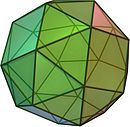|
Snub cube
In geometry, the snub cube, or snub cuboctahedron, is an Archimedean solid with 38 faces: 6 squares and 32 equilateral triangles. It has 60 edges and 24 vertices. Kepler first named it in Latin as cubus simus in 1619 in his Harmonices Mundi.[1] H. S. M. Coxeter, noting it could be derived equally from the octahedron as the cube, called it snub cuboctahedron, with a vertical extended Schläfli symbol , and representing an alternation of a truncated cuboctahedron, which has Schläfli symbol . ConstructionThe snub cube can be generated by taking the six faces of the cube, pulling them outward so they no longer touch, then giving them each a small rotation on their centers (all clockwise or all counter-clockwise) until the spaces between can be filled with equilateral triangles.[2]  The snub cube may also be constructed from a rhombicuboctahedron. It started by twisting its square face (in blue), allowing its triangles (in red) to be automatically twisted in opposite directions, forming other square faces (in white) to be skewed quadrilaterals that can be filled in two equilateral triangles.[3] The snub cube can also be derived from the truncated cuboctahedron by the process of alternation. 24 vertices of the truncated cuboctahedron form a polyhedron topologically equivalent to the snub cube; the other 24 form its mirror-image. The resulting polyhedron is vertex-transitive but not uniform. Uniform alternation of a truncated cuboctahedron Cartesian coordinatesCartesian coordinates for the vertices of a snub cube are all the even permutations of with an even number of plus signs, along with all the odd permutations with an odd number of plus signs, where is the tribonacci constant.[4] Taking the even permutations with an odd number of plus signs, and the odd permutations with an even number of plus signs, gives a different snub cube, the mirror image. Taking them together yields the compound of two snub cubes. This snub cube has edges of length , a number which satisfies the equation and can be written as To get a snub cube with unit edge length, divide all the coordinates above by the value α given above. Properties For a snub cube with edge length , its surface area and volume are:[5] The snub cube is an Archimedean solid, meaning it is a highly symmetric and semi-regular polyhedron, and two or more different regular polygonal faces meet in a vertex.[6] It is chiral, meaning there are two distinct forms whenever being mirrored. Therefore, the snub cube has the rotational octahedral symmetry .[7][8] The polygonal faces that meet for every vertex are four equilateral triangles and one square, and the vertex figure of a snub cube is . The dual polyhedron of a snub cube is pentagonal icositetrahedron, a Catalan solid.[9] Graph The skeleton of a snub cube can be represented as a graph with 24 vertices and 60 edges, an Archimedean graph.[10] References
External links
|
||||||||||||||||||||||||||||














![{\displaystyle {\begin{aligned}\alpha &={\sqrt {{\frac {4}{3}}-{\frac {16}{3\beta }}+{\frac {2\beta }{3}}}}\approx 1.609\,72\\\beta &={\sqrt[{3}]{26+6{\sqrt {33}}}}.\end{aligned}}}](https://wikimedia.org/api/rest_v1/media/math/render/svg/dcce93203241f81fe890e5c1ab8cdd80476937e8)

















